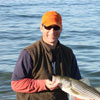4 More Tips on How to Read a Fishing Report
By Tom Keer
Feb 28, 2017
Fishing reports provide invaluable information for figuring out where the fish are biting and what they're eating. Cross reference your sources to determine patterns and take your fishing to the next level.
A lot of information is contained in fishing reports such as where the fishing is hot and what lures are working best. Sometimes, reading between the lines is the best way to learn how to read a fishing report, and here are some ways to get a bead on what's happening and to put it to good use.
1. Tackle shops and guides. Tackle shops and guides are excellent sources for information. That said, if a shop expert or a professional guide tells you where to go then you don't need their services. Knowing how to interpret their advice is key, and better information comes your way if you're part of the team. Buy gear from the shop and refer customers to the guides. Both will see you as a team member, and they'll pass along an inside track towards hot fishing.
2. Look for Patterns. There are lots of online fishing reports which makes it easy to have lots of eyes on the water. Cross reference professional guide, tackle shop and recreational angler reports to see what's what. Then, look for patterns. Are the fish sluggish due to a specific type of weather? Are they favoring live bait to spoons or soft plastics? Is it a recent rain that turned on the fishing? Use fishing reports to better understand how good fishing happens and why it doesn't.
3. Know when to take it off line. Spot burning can be a problem, especially since online fishing reports reach tons of readers. Some discussions are best had off line, so take specific areas or coordinates offline.
4. Consider the species. Some fish, like saltwater species or fish in lakes move around while river fish are more stationary. Heartburn develops if you read a report and go to the spot where they said the fishing was hot. Some fish move, so a saltwater fishing report might show hot fishing from yesterday or today. But tomorrow when you go the school has moved and it's quiet. Look at local fishing reports from neighboring areas to keep track on the fishs' movements and use the fishing report to forecast where the fish go next.
There is more fishing information available than ever before, and that's why knowing how to read a fishing report is so important. Separate the facts from the fiction, read between the lines, and study the patterns.
1. Tackle shops and guides. Tackle shops and guides are excellent sources for information. That said, if a shop expert or a professional guide tells you where to go then you don't need their services. Knowing how to interpret their advice is key, and better information comes your way if you're part of the team. Buy gear from the shop and refer customers to the guides. Both will see you as a team member, and they'll pass along an inside track towards hot fishing.
2. Look for Patterns. There are lots of online fishing reports which makes it easy to have lots of eyes on the water. Cross reference professional guide, tackle shop and recreational angler reports to see what's what. Then, look for patterns. Are the fish sluggish due to a specific type of weather? Are they favoring live bait to spoons or soft plastics? Is it a recent rain that turned on the fishing? Use fishing reports to better understand how good fishing happens and why it doesn't.
3. Know when to take it off line. Spot burning can be a problem, especially since online fishing reports reach tons of readers. Some discussions are best had off line, so take specific areas or coordinates offline.
4. Consider the species. Some fish, like saltwater species or fish in lakes move around while river fish are more stationary. Heartburn develops if you read a report and go to the spot where they said the fishing was hot. Some fish move, so a saltwater fishing report might show hot fishing from yesterday or today. But tomorrow when you go the school has moved and it's quiet. Look at local fishing reports from neighboring areas to keep track on the fishs' movements and use the fishing report to forecast where the fish go next.
There is more fishing information available than ever before, and that's why knowing how to read a fishing report is so important. Separate the facts from the fiction, read between the lines, and study the patterns.
Popular Posts









